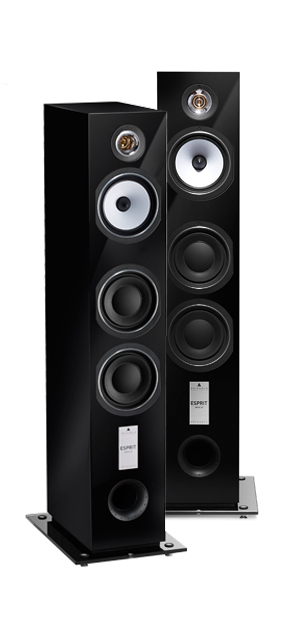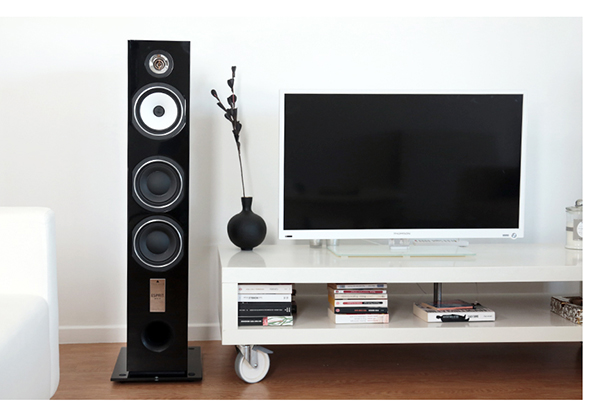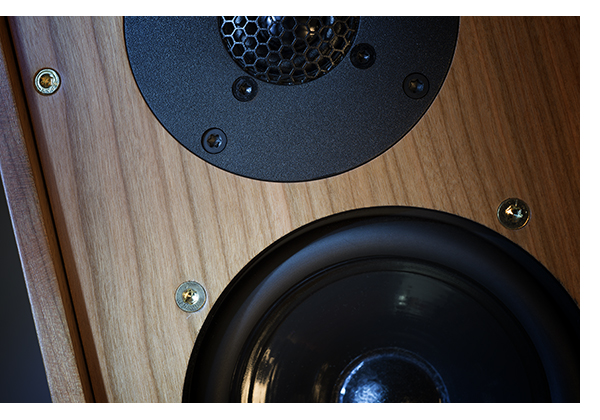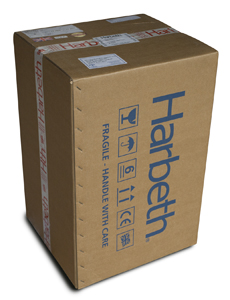 Maybe it’s the concert halls, but so many European speakers have a thing for tonal accuracy, and Triangle is no exception. After spending a lot of time listening to the Triangle Antal Ez speakers from their Esprit line, I’ve come away highly impressed. The high gloss piano black (white and walnut veneer also available) towers stand approximately 44” tall by 12” wide and 15.75” deep.
Maybe it’s the concert halls, but so many European speakers have a thing for tonal accuracy, and Triangle is no exception. After spending a lot of time listening to the Triangle Antal Ez speakers from their Esprit line, I’ve come away highly impressed. The high gloss piano black (white and walnut veneer also available) towers stand approximately 44” tall by 12” wide and 15.75” deep.
The unique and very stable glass bases and rubber or spiked feet take about five minutes each to attach. Out of the box the Antal Ez’s were slightly tight and flat sounding, but they came alive after a few days of constant play. Initial listening took place in my 9’ x 12’ dedicated listening room, but these speakers begged to be heard in my larger 15’ x 19’ living room – and they are an excellent match.
Optimizing these speakers is well worth the effort, and good as they sound randomly placed, major gains in imaging and soundstage are achieved once your homework is done. Perfection in my space arrived with the Antal EZ’s eight feet apart and the rear panels 29 inches in front of the bay window.
Getting immediately into the groove with Issac Hayes’ Shaft soundtrack paints a massive sound field in the room. Hayes masterful use of various instruments gets full exposure with these black monoliths. The synthesizer steps out in front nicely and playfully bounces between the channels, with the beat solidly locked down.
A 92db sensitivity rating makes the EZs easy to integrate with whatever amplification you might have on hand. Even my vintage 20wpc Pioneer receiver that I use for speaker break-in gets these speakers up and jumping. Even though the EZs have a fairly high sensitivity rating, I suggest a bit more power, should you be going with tube electronics. (a bit more of a word from our publisher at the end of the review)
The tech inside
Triangle’s fascinating TZ2510 tweeter tucks a titanium dome inside a compression chamber, allows the hi-hat and flute in Hayes’ Oscar-winning theme song to propel throughout the listening space in delicious detail. This is a tweeter that has to be heard, providing both expansive detail and silky-smooth response. Much credit for the natural clarity Triangle states comes from the elimination of back standing waves. The mid-song, crystal clear tambourine in “Shaft” is placed solidly, just outside the right speaker boundaries – impressive.
Another hot spot for me is the reproduction of the harmonica, which easily gets shrill and brittle with lesser speakers. The EZs make this an instrument you’ll look forward to hearing, whether it’s classic Bob Dylan, Neil Young, or any other favorite track you might have in mind. Mick Jagger’s intro to “Hoo Doo Blues” is simply sublime, giving this instrument the smoothness and texture it deserves.
Matched up with the titanium tweeter is a single 6.5” white cellulose (paper) cone driver for the midrange frequencies, and dual 6.5” black fiberglass bass drivers. A bass port sits at the bottom of the front face. A rectangular magnetic grill is provided for owners desiring protection from kids, dogs, and the elements. The backside has only a brushed aluminum panel with dual locking copper banana plug binding posts, featuring first rate wire jumpers. This three-way design is housed in a high-density cabinet wrapped in a silky finish.
Stunning as the TZ2510 tweeter is as a design element, it’s blend into the entire system provides head turning vocal clarity. The Antal Ez elevates any singer’s performance by a couple of notches. The lack of electronic haze adds an additional level of clarity to everything in your music collection. Holly Cole’s hi-rez vocal rendition of “Tennessee Waltz” is so tight, the slightest inflections become apparent.
Garth Brooks voice in the haunting “The Thunder Rolls” presents such detail on the Antal Ez’s that I spotted a specific Oklahoma accent point that a friend told me was common of people from Canadian County where Brooks was raised. The ability to pick out such vocal subtleties is something completely unexpected at under five figures, and mind-blowing at $2,750 a pair. ($2,995 for a few optional finishes)
This level of pace and clarity is available at any listening levels, but to their credit the EZ’s retain their resolution at low level as well. Lorde’s Melodrama is a favorite test track at moderate to loud volume around here; but even at a low 77db listening level, I could still catch the nuances in her voice as she subtly shifts from speaking to singing, and the driving bass line is still awash in reverb.
The Antal Ez’s are at their best when playing tracks combining wide dynamics and imaging. Like Isaac Hayes, Electric Light Orchestra thrives on both of the above traits, and in celebration of the recent, Guardians of the Galaxy, the vocals in “Mr. Blue Sky” pushes well to the outside of the speaker boundaries. Imagine Dragons Evolve album uses many of the sonic techniques of ELO. “Believer” swings between various dynamic moments that the Antal Ez’s recreate with ease.
Classical fans take note; the Ezs ability to project true detail of a full orchestra is top notch. Though rated down to 40hz, a little bit of room gain goes a long way to create a strong impression of deeper bass. The larger your room, the more you will be able to take advantage of the wide soundstage these speakers are capable of. For my money, the Triangle Esprit Antal EZ speaker are just plain awesome. Combining punchy dynamics, wide dispersion and phenominal imaging, they bring every musical selection to life. The way they draw out subtle musical artifacts makes them a joy to listen to.
Further Listening – Jeff Dorgay
I must concur with Mark’s analysis; these speakers are very dynamic and throw a huge three-dimensional image. Always catnip for this writer. I had a bit better luck mating the EZs to tube amplification than he did, but to be fair, I have a much wider range of amplifiers at my disposal. Though the 92db sensitivity rating suggests this might be a heavenly match with low powered tube amplifiers, this is not the case. My 20wpc Nagra amplifier fell down just as flat as his Vista i34 amplifier did.
Moving up the food chain to about 60wpc is what you really want to achieve tubey magic with these speakers. The Conrad-Johnson Classic 62 and the PrimaLuna DiaLogue HP both offer stunning performance spatially and dynamically, with plenty of bass extension and control. These speakers need a bit of current drive to achieve maximum effect.
Give these speakers a little bit of space and an amplifier with a bit of drive and you’ll be glad you did. And at this price, they are more than worthy of one of our last Exceptional Value Awards for 2017. We’ll be back with more Triangle product shortly, their new, small powered speakers are already in house and equally enchanting.
 The Triangle Esprit Antal EZ Speakers
The Triangle Esprit Antal EZ Speakers
$2,750/pair – $2,999/pair (finish dependent)
Peripherals (MM)
Analog Source Rega RP1 w/Ortofon Super OM40/Sim LP5.3
Digital Source Simaudio 300D DAC
Amplification i7 Integrated Amplifier, Peachtree Nova 150
Cable Cardas Clear, Shunyata Venom 3 PCs
Peripherals (JD)
Analog Source Technics SL-1200G/Grado Statement 2
Digital Source PS Audio DirectStream DAC and Disc Player
Amplification Esoteric F-07, PrimaLuna DiaLogue HP
Cable Cardas Clear






 Tonemasters
Tonemasters Chameleon – like
Chameleon – like










